It was during travel with my brother Lubos in Lombok when I thought it would be nice to visit a pearl farm.
I have learned that Lombok is famous for production of beautiful Golden South Sea pearls and I was determined to get some. Starting with minimal research of locations of pearl farms around Lombok I have followed travel guide lead and travelled from Senggigi to south west of Lombok to find mentioned pearl farms.
As usual our scooter mission, finding a pearl farms resulted in getting lost for about four hours before we found one pearl farm just by coincidently stopping right in front of it (somewhere around Sekoton area). We could see oyster beds from the shore, but couldn’t find anybody who would tell us how to get to the producer. Most of the people didn’t seem to be even aware that these are places where pearls grow. It is important to mention that Lombok is incredibly beautiful island. It is still nice and green and not very touristy which also means that out of major towns not many people speak English. It also appear to me that not many locals travel too far from their villages as it seems that they are not aware what is located in next village (for example; famous waterfall, factory, bus station, ferry terminal or pearl farm).
To our big luck we happen to find the farm when the owner Mr Mahmud A.md was visiting his farm ABI PEARL and was so kind to give us a tour and explain to us process of cultivating pearls.
Mr Mahmud A.md has established ABI Pearl about ten years ago, he specialize in collecting all kind of natural and cultured pears from across the world especially Indonesia and culturing his own Golden South Sea pears. Mr Mahmud has spent two years sailing across Indonesia with his friend who thought him how to find and dive for natural pearls. Today Mr Mahmud has impressive collection of more than 70 different kinds of natural pearls including their mother shells. My brother and I were very lucky to see part of this collection in Mr Mahmud’s house where he has invited us to. Sorry, no photos of this treasure as we were both too overwhelmed to remember to take some.
The farm itself doesn’t look very big above the water, but under the water are living hundreds of Pinctada maxima – Golden South See pearl oysters. As oysters are very susceptible to environmental conditions constant breading of new baby oysters is in the place while growth of pearls is being managed.
Below are pictures of mother oysters kept for reproduction.
When baby oysters are about one month old they are removed from their breading nets, separated and cleaned up. Then they are placed in small metal mash pockets and suspended back in to the water from floating rafts where they grow further. Floating rafts are usually located in sheltered bays where oyster can grow and feed in nutritious waters.
The cleaning process is mainly done by women as their fingers are usually smaller and gentler.
When the oyster is big/old enough the irritant (small polished shell bead made usually from fresh water oyster and tissue implant from a donor oyster) is carefully inserted into mollusk’s soft layer. Mollusk then starts covering the irritant with layers of nackre which over the time forms pearl. Nackre is a soft, shiny layer that covers inside of the oyster shell. This process is done with enormous level of precision and focus as oyster will allow only about 20-30mm opening of the shell, any larger opening will cause oyster to reject the implant.
In case of natural pearls it is when parasite (grain of sand, coral or fish part) enters into shell’s mollusk’s soft layer and shell is injured. Shell then in healing process covers the parasite in nacre and forms pearl, which in general, gets bigger, longer it stays in a shell.
Period of growth of cultured pearls depends on several factors. Firstly, it depends on how fast the mollusc recovers from implanting process. For South Sea Pearls this can take up to 3 months. Secondly, growth of nacre greatly depends on environmental conditions such as pollution, water temperature and season of the year. In average, it takes about a year to grow 2mm of nacre in case of South Sea pearls. Lastly, size of implanted shell bead will also determine the final size of grown pearl. Typically, for South Sea pearl it takes about 2-3 years to reach about 15mm in diameter.
South Sea pearls produce one pearl at the time and are harvested every 2-4 years. If the grown pearl is carefully surgically removed and the shell is not harmed new, larger bead can be inserted in the shell at the same time. Shell is then returned back to the water for another 3 years and the process repeats. This process, I believe, can be replicated only three times before shell dies.
Due to this extensive growth process it is important to keep oysters clean of any sediments and vegetation as this attracts parasites that can harm the oyster. Therefore, cleaning is done regularly manually, but also with help of environment. ABI Pearl farm is located on reef which attracts lots of fish that loves to nibble on natural coverage of the shell. Pearl oysters, like reef are very sensitive to water pollution and change of water temperature, which affects the growth and quality of the pearl. Thus the quality of the water and temperature is constantly monitored. For the cleaning, oysters are lifted out of water and hand cleaned then is suspended from floating raft back in the water. Oyster can survive out of the water up to 24 hours so this process can take place above the water. Interestingly sea salt oyster will die in fresh water after certain amount of time, however, it is fresh water that is used to heal oyster from diseases. How does one know when oyster is sick? Oyster is naturally very strong and it is hard to open it, yet when it starts opening on its own or very easily with your help, it is a sign that oyster is unwell and needs healing. In that case, oyster is placed for 30min into fresh water which often cures the problem.
It is the type of oyster that determines the body colour of the pearl. For Lombok it is typical to produce golden pearls from Pinctada maxima that loves warm waters of Indonesia. Therefore, I was very interested in selecting and purchasing only mind-blowing golden pearls here in Lombok. South See pearls are most valuable among cultured pearls mainly due to their size. Pinctada maxima is capable of producing largest pearls because it is relatively large oyster and is capable of receiving large irritant to begging with. This oyster also lives in warm waters speeds up oyster’s metabolism and production of nacre.
Friendliness and hospitality of Mr Mahmud was unbelievable. Not only he took the time to explain to us the process, answer our questions, take us for snorkeling on his reef, organized for us this yummy freshly caught fish but also invited us to his house for tea and demonstration of his natural pearl collection.
Mr Mahmud, my brother Lubos and I at the farm
One of Mr Mahmud’s shops. Today, Mr Mahmud provides number of job opportunities at his pearl farm as well as in his shops. What a journey and results in ten years!
If you are interested to get in touch with Mr Mahmud Amd you can contact him on:
Mobile : +6281 7571 1617 or +6281 907 086 775 or +6281 917 121 256
Telp : ( 0370 ) 636 097
E-mail : abi_lombok_pearl@yahoo.com or abipearl@bismillah.com
Website : www.abipearl.com or www.mutiaralombok.com

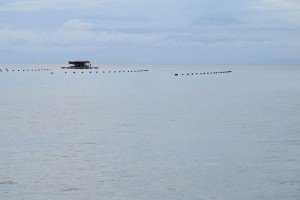
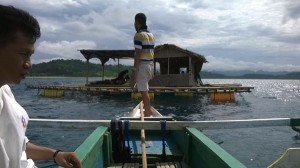
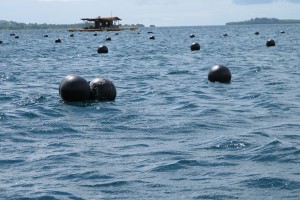
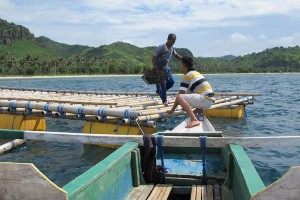
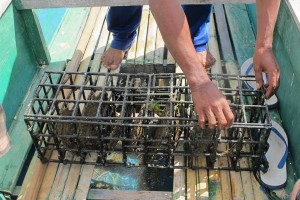
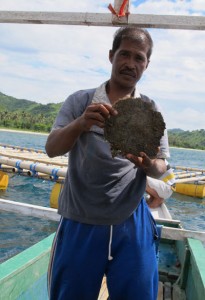
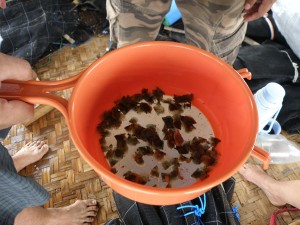
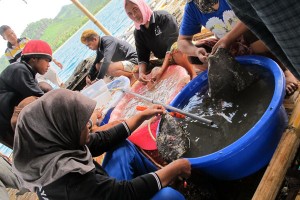
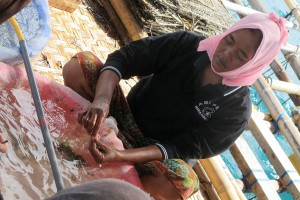
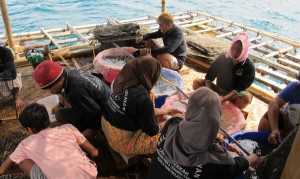
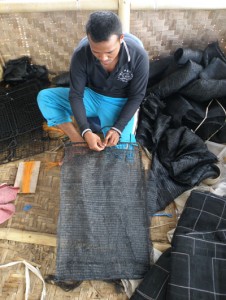
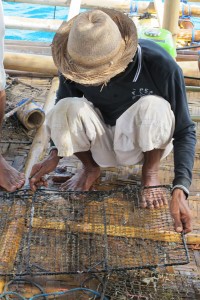
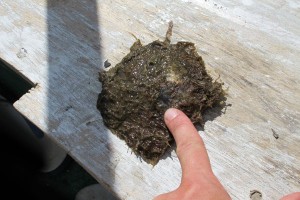
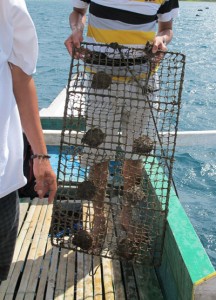
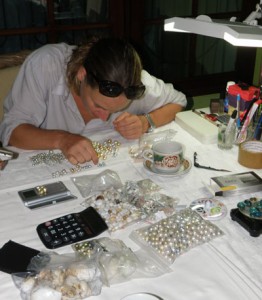
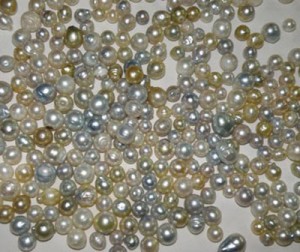
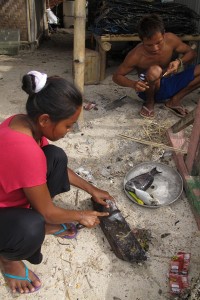
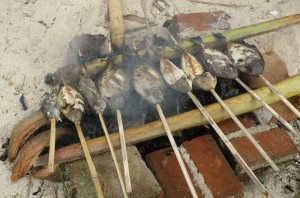
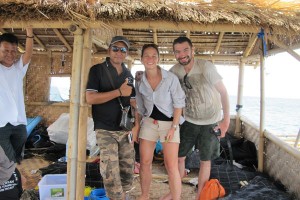
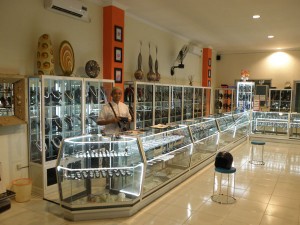
{ 1 comment… read it below or add one }
Wow, looks like it was awesome tour! You guys got so lucky!
Thanks for sharing, learned a lot about pearl farming 🙂